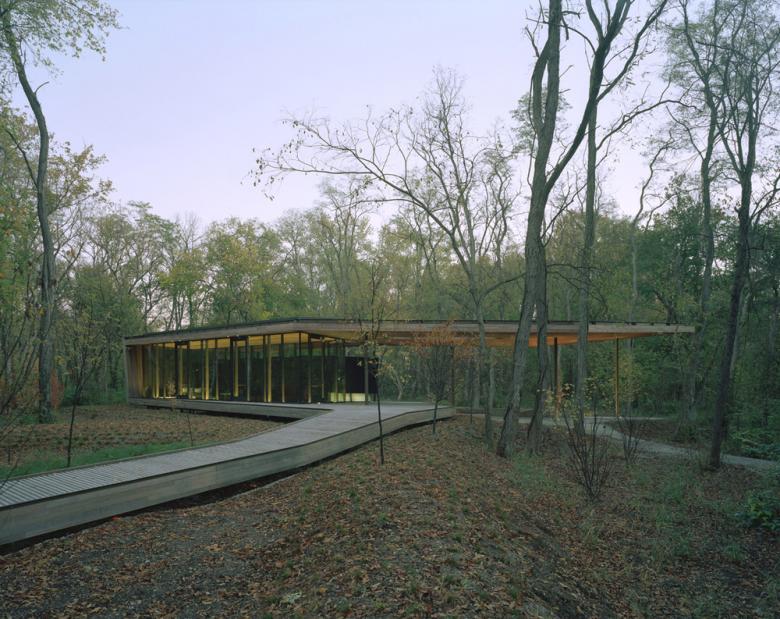Indianapolis Museum of Art Visitors Pavilion
Indianapolis Museum of Art Visitors Pavilion
24. October 2011
Located between the Indianapolis Museum of Art and the White River, 100 Acres: The Virginia B. Fairbanks Art & Nature Park is a large outdoor canvas for exploring the relationship between contemporary art and nature. This happens via site-specific commissions, educational programs, partnerships with local groups, and now the Ruth Lilly Visitors Pavilion with gathering and education spaces, and restrooms. This cornerstone of the park designed by Marlon Blackwell takes its inspiration from a fallen leaf, evident in the wood-slat roof and its pierced openings. The architect answered some questions about the project.
The approach from the west
What were the circumstances of receiving the commission for this project?
The project began as an investigation of possibility. The museum owned approximately 100 acres adjacent to the main museum that sat in an oxbow of the White River, and was cut off by a canal built in the 1920s. Although connected to the trail system in Indianapolis, the area was far from an amenity and often a source of troublesome activity. We eventually won the competition by describing the way we would approach the investigation as a team and produced a book that documented the site and its potential in great detail. This became the foundation for the 100 Acres Art & Nature Park and the subsequent building, but the process took nearly seven years.
Looking at the pavilion from the east
How does the completed building compare to the project as designed? Were there any dramatic changes between the two and/or lessons learned during construction?
The completed building, although smaller than what was originally designed, embodies the spirit and the critical details of the original, known then as the Interpretive Pavilion which had three enclosed wings. As financial conditions changed, we had to scale back the size and scope of the project, and settled on the current version of the Visitors Pavilion. Remarkably, the design was relatively adept at changing into a singular form. Before construction began, the site was incredibly dense with vegetation, so it was difficult to really get a sense of the site and how the structure would fit. As the building emerged, we became more and more satisfied with how appropriate the scale of the structure was for the site.
Inside the pavilion
How does the building compare to other projects in your office, be it the same or other building types?
The Ruth Lilly Visitors Pavilion is unique within the office in the sense that it was out of state and was associated with an art museum, but the process by which it was designed isn't any different than any other project we undertake. We firmly believe that architecture can happen anywhere and it doesn't take museum budgets to do so. We were able to achieve a level of detail that isn't common to many projects, whether in our office or not. In that regard, we give credit to the museum for their commitment to the project and to that level of detail and to the contractor for their craftsmanship.
Floor plan
How does the building relate to contemporary architectural trends, be it sustainability, technology, etc.?
Although the Visitors Pavilion will be LEED Certified (commissioning was just completed) and has many sustainable features, we attempted to integrate them seamlessly. Most people will never know that there is a geothermal system or that we use well water taken on site. We are firm believers in the power of building well, and in making spaces that people value and take care of over the long term, and that in itself is deeply sustainable. So, even though the building doesn't actively promote itself as sustainable, we are proud that we can provide a design of the highest aspirations that can be environmentally responsible too in a time when it often seems we get to choose between the two.
Exploded axonometric
Are there any new/upcoming projects in your office that this building’s design and construction has influenced?
In terms of form, probably not, but there are many lessons we learned, things the Visitors Pavilion taught us I would go so far to say, about light and detail that definitely live on. The exploration of filtered light through wood screens that began with the Tower House a long time ago evolved in the Visitors Pavilion and will be seen again in a new form in the Museum Store at the Crystal Bridges Museum of American Art. Our experience with the custom curtain wall at the Visitors Pavilion deeply influenced our expectations and detailing of the curtain wall for the Steven L. Anderson Design Center, which is a modern 37,000-sf addition to the existing School of Architecture at the University of Arkansas, a Beaux Arts building built in the 1930s. Rather than there being a direct lineage between this project and another, we see an ongoing and emerging genealogy between projects as they influence one another and adapt to emerging conditions.
E-Mail Interview conducted by John Hill
Longitudinal section
Indianapolis Museum of Art Visitors Pavilion
2010
Indianapolis, Indiana
Client
The Indianapolis Museum of Art
Architect
Marlon Blackwell Architect
Fayetteville
Principal in Charge
Marlon Blackwell
Project Manager
Jonathan Boelkins
Project Team
Chris M. Baribeau, AIA
Gail Shepherd, AIA
Meryati Johari Blackwell, LEED AP
Mark Rukamathu
Matt Griffith, AIA
Mark Wise
Bradford Payne
Stephen Reyenga
Michael Pope
Angela Carpenter
David Tanner
Ignacio Gonzalez
Structural Engineer
Guy Nordenson & Associates
New York
MEP/FP Engineer
L’Acquis Consulting Engineers
Civil Engineer
Cripe Architects & Engineers
Landscape Architects
The Landscape Studio and NINebark
Environmental Artist
Mary Miss
Acoustical
Dr. Tahar Messadi
Building Codes & Fire Safety
Ralph Gerdes Consultants
General Contractor
Geupel DeMars Hagerman
Site Area
0.67 acres
Building Area
1,290 sf
Photos
Timothy Hursley
Related articles
-
Spotlight on Italy
on 5/16/18
-
Bologna Shoah Memorial
on 7/20/15





